| A Guide to Brushes |
 |
| When it comes to brushes, there are many different types, that way you'll always be able to find at least one to your liking. Each type of brush comes in a different shape and size in order to create a certain texture and thickness. Along with different styles of brushes comes different materials these brushes can be made from. The material a brush is made from can affect the quality of not only the brushes lifespan but the work created with it as well. Lastly, it is very important to understand the proper maintenance of a brush as the better you take care of something, the longer it will last. In this article, we will discuss 6 different kinds of brushes and what they are used for.
|
| Types of Brushes |
 |
| A Round Brush has all the bristles come to a point. Round Brushes are best used for broad or fine details depending on the size and are overall a staple brush when it comes to painting.
A Flat Brush has the bristles formed in a flat square shape. This shape creates a perfect sharp edge with the straight tip of the brush. This brush is also useful in creating both thick and thin lines depending on the angle, as well as great for blocking in solid shapes.
A Bright Brush is similar to a Flat Brush with its flat square shape however the bristles are shorter overall. Like the Flat Brush, a Bright Brush also creates a sharp edge. However a Bright Brush is best used for short controlled strokes.
A Filbert Brush is a flat brush with a rounded tip like an oval shape. This rounded edge is perfect for creating strokes with no hard edges.
A Fan or Blender Brush is a wide flat brush that fans out in the shape of a V. This brush can be used to smooth out already painted strokes as well as can be used to create texture.
A Liner, Script, or Rigger Brush is a long, very thin tipped brush. This brush is best used for fine details or lettering. The extra long bristles are able to hold more paint which allows for long painted linework.
|

Round Brush
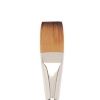
Flat Brush
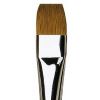
Bright Brush
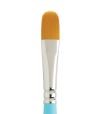
Filbert Brush
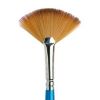
Fan or Blender Brush
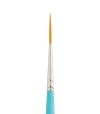
Liner, Script, or Rigger Brush
|
| Types of Brush Hair |
 |
| Along with all these different shaped brushes comes a wide variety of materials that these brushes can be made up of. We will be discussing six different materials and what they come from.
Kolinsky is one of the finest materials available. Coming from the remote regions of Russia and China, this soft hair comes from the pelt of a mink or weasel.
Red Sable comes from the red haired weasel and is capable of holding a large amount of pigment. As well, this material is able to hold shape well which assists in creating smooth flat strokes.
Sabeline comes from high quality Oxen hair yet is less expensive than the Red Sable. Overall this material maintains many of the same qualities as the Red Sable (such as brush stroke quality) other than affordability.
Ox Hair comes from the hair of a cattle or boar. This material is quite soft and is able to hold plenty of liquid however, it lacks in creating a fine tipped stroke.
Camel Hair comes from that of a goat, pony, or squirrel's hair which makes this material extremely affordable. As well, this material is able to absorb a great amount of liquid however this can create a difficulty in controlling the brush strokes.
Lastly, there is Synthetic brushes which are made of nylon or polyester. These less expensive brushes are easier to clean and less prone to breakage due to their man made nature.
|

Kolinsky and Red Sable

Sabeline
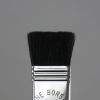
Ox Hair
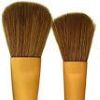
Camel Hair
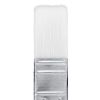
Synthetic
|
| The Ethics of Brushes |
 |
| It is important to note that many animals used for paint brushes are cruelly killed for their fur much like those used for fur coats. These animals have been hunted, trapped, and gassed for their fur/hair and it is important to research exactly where your materials are coming from. In some instances, certain animals like horses or goats may have been groomed and had their clippings donated, but more times than not animals are cruelly killed. On the flip side, synthetic brushes may be cruelty free but they are not eco friendly. With synthetics taking over 450 years to decompose. Overall, it is important to do your own research on where to purchase your brushes from and consider alternatives. These alternatives can be as simple as giving up brushes and using palette knives, sponges, roller brushes, or even your hands depending on the type of project. You could even make your own brushes! There are many options to consider with an openmind.
|
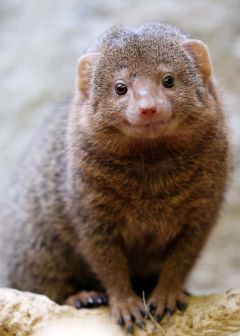
Think before you buy!
|
| Brush Care and Maintenance |
 |
|
Even though brushes can come in many different shapes and be made up of many different materials, they all need the proper care and maintenance in order to last. It's important to never let any brush rest hair side down as this can ruin the bristles. Instead rest the brush horizontally or vertically but with the bristles pointed up towards the sky. It is also good to clean the brushes immediately after using them or in between colours, and not just when you're done using them. This is because paint can easily dry on the brush if not in use as well as the bristles can be miss-shapen if left sitting in water for too long. The type of washing method can depend on the type of paint used on the brush. After using water based paints, cleaning with soap and tap water will work just fine on brushes. Whereas after using oil or alkyd based paints, you should wash with turpentine and mineral spirits. Make sure to gently massage the bristles when cleaning and always work in the direction of the bristles and not against. A good way to test if a brush is clean is to wipe it against your wrist a few times and if no colour shows up then it is clean. Lastly, always reshape the bristles after washing so that they dry in the proper form.
|
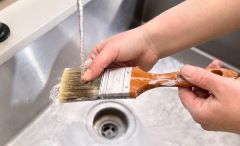
Standard brush cleaning
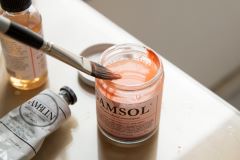
Cleaning oil paint with solvent
|
| Overview |
 |
|
Now you should have a basic understanding of brushes broken down into the three categories; brush shapes, brush materials, and how to care for your brush. With there being six main brush shapes; Round, Flat, Bright, Filbert, Fan/Blender, and Liner/Script/Rigger Brushes. If you're new to painting, a Round and Flat brush are the perfect starter pair as these staples are easy to use for many techniques. As well as six different brush materials; Kolinsky, Red Sable, Sabeline, Ox Hair, Camel Hair, and Synthetic. Furthermore the proper wash and care can depend on the type of paint being used. Most importantly, the better you take care of something, the longer it will last! We hope you found this article helpful for your research on brushes. For further information, we encourage you to read MacPherson's guide on Art Fundamentals-Brushes | MacPherson's.
|

KeenART Media
|
|
If you have questions about any of our services or products, don't hesitate to contact us. Our knowledgeable staff is always happy to assist with answers, advice, or suggestions.
For articles on mediums and gesso, click here!
For more information on types of paint, click here!
For a guide to beginner oil painting, click here!
|
|

|



|
USA Giclee On Canvas, Fine Art Printing - Art Scanning & Reproductions - Handmade Oil Paintings - Custom Wood Panels, Metal Picture Framing - Block/Plaque Mountings, Large Format Dry Mounting & Lamination - Art Supplies: Stretcher Bars, Cradled Wood Panels and Artist Canvas - Collages On Canvas - Plexi/Acrylic Face Mounts - Block Acrylics, Fabric Printing, Dye Sublimation - Cityscape Skyline Prints, Resin, Photo Gifts and more...
|
|
© 2002-2025 - KeenART Media Ltd.
|
|
| |
|
